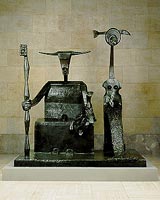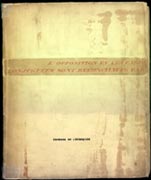"A very normal guy" Robert
Barnes on Marcel Duchamp and Étant Donnés
Tout-Fait: You were getting rid of his trash and then you bumped into him again when you were in New York. Robert Barnes: Yeah. That's a real odd coincidence because I worked with a friend and we would collect trash from rich people. And Max lived in Sedona then. I wonder what happened to that place. I'm sure his son Jimmy got it and Jimmy is dead now. Tout-Fait: He was not rich really.
Robert Barnes: No, but we thought he was rich. We didn't have anything. But we would go around to these homes in Sedona and offer to get rid of their garbage. And in places like that garbage is big business, you never get rid of it. And we offered to take it and dispose of it in a "clean and orderly fashion," which meant we would dump it in any place we could where no one would see it. My friend had a pick-up truck - all Navahos if they have a vehicle, have turquoise pick-up. And we loaded it up with this plaster from this guy's home, with faces on it, they were kind of interesting, and dumped them. So somewhere up there if you want to excavate, there's a whole bunch of rejected Max Ernst sculpture. I have a picture of myself sitting on his "King and Queen"-sculpture (Fig. 25) (12). I looked like I was twelve. Tout-Fait: While you were down there? Robert Barnes: Yeah. Tout-Fait: Who took the picture of you, your friend? Robert Barnes: Yeah. Max Ernst was very shadowy. Whenever he stayed in New York, he stayed at Marcel's. Tout-Fait: What about Man Ray? Robert Barnes: I didn't like him. Tout-Fait: You mentioned that Duchamp once introduced you to a dealer of ethnic art. Robert Barnes: Yeah, Carlebach I think he was called. Tout-Fait: Did he take you there? Robert Barnes: The first time, I went with him. Carlebach was a dealer in ethnic material and he had this store filled, it was what you would expect a junk shop to have, filled from floor to ceiling with all of these ju-ju's. You could buy an African sculpture for a couple hundred dollars or less. Tout-Fait: So Duchamp brought you there because he liked the place? Robert Barnes: Yes. Tout-Fait: Was there any literature that he recommended to you? Robert Barnes: Oh yeah. Dujardin and Lautréamont, they all loved Lautréamont, but I'm not going to get into that. The book that was most like Marcel, I don't know wether he loved it or not, was by À Rebours by Huysmans, Against the Grain. It was so like Marcel. That's a story of art. Put too much on it and it's going to die. Actually, Marcel introduced me to French literature, Camus, Céline, he was a bad boy. And of course I never liked Beckett. Beckett is the literary equivalent of Bergmann films, which at the time were very exciting, but if you saw them again, you would get very embarrassed (13).
Tout-Fait: So Duchamp introduced you to Beckett. Robert Barnes: Yeah, he mentioned it and then I read it. Tout-Fait: Beckett's End Game might in part be based on Marcel's chess game problem (14) (Fig. 26). Do you play chess? Robert Barnes: Yes, I hate it. I absolutely hate it. I played with Marcel because he liked to play with people who didn't know how to play chess. You know, a chess champion is used to gambits and if he plays with someone who has no idea what they should be doing, it is almost more taxing. He liked that. I would put the pieces in positions that I thought were decorative. And of course I would surrender. Tout-Fait: Did he teach you? Robert Barnes: No, it was just a pastime. And what would happen would be that I would sacrifice so many pieces that it was very hard to get a checkmate. Everything is being sacrificed and it was just totally disorganized and I think that was something that Marcel liked. Tout-Fait: There is this story that he got annoyed with John Cage (15) complaining that Cage never even tried to win. So there was also something where people were good chess players and he just didn't think that they were trying hard enough to beat him. Robert Barnes: That was a strange relationship. Didn't Cage hate Étant Donnés? Tout-Fait: I don't know about that. Robert Barnes: It was a weird relationship and I think egos went… Tout-Fait: But Cage owes a lot to Duchamp. It's not the other way around. But now for something completely different: Paul Swan I'm supposed to ask you about. So who was Paul Swan? Robert Barnes: God, if there was a Duchampian theater, it was Paul Swan. I did paintings with Paul Swan, I'll show you one later, pastels. Paul Swan was an occupant of the apartments in the Carnegie Hall when the Carnegie Hall was great and real before it was fixed and made up for the deluxe world. In Carnegie Hall there were apartments and they were slowly getting rid of people who were in these apartments because they wanted them back either for space or for rich people. But Paul Swan held on. It was like, you know, what happened in New York with rent control.
Notes
Fig.
26
|














